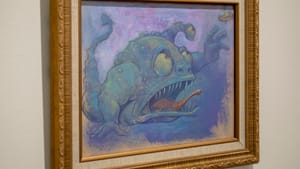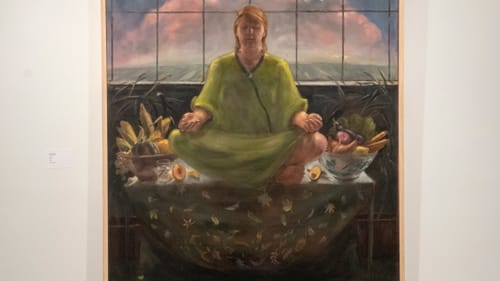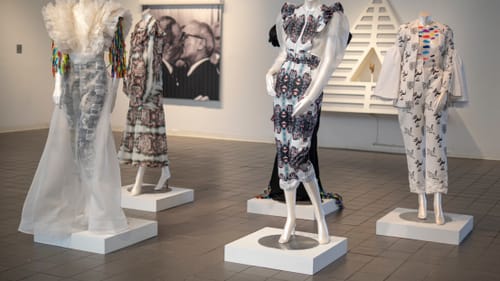Stay in the Loop
BSR publishes on a weekly schedule, with an email newsletter every Wednesday and Thursday morning. There’s no paywall, and subscribing is always free.
Teaching and doing
Moore College of Art and Design presents its Faculty Triennial

With 49 artists involved, variety is a given, but there’s more than variety in the Faculty Triennial at Moore College of Art and Design. Each work is an idea: a message conveyed in oil, fabric, ink, or metal. Some signal their artiness with a frame or otherworldly appearance, but some are pedestrian — they could be found on a shelf, in a closet, or on a desk — making viewers think, “Oh, that’s art too?” and see their surroundings with new eyes.
For the representationally minded, Joyce Millman’s still life Gerberas and Citrus (2017) is a lemony tonic for winter-dulled eyes. John Rais’s steel sculpture Raven (2019) is worthy of Poe and tall enough to perch next to a chair and hold your glass. Jeff Dion’s Earth (2018), depicting a woman in the lotus position, is similarly therapeutic, provided you don’t look too closely. Don’t ask how she came to be cross-legged on a table, meditating between bowls of squash and eggplant, or think about how close that paring knife is to her foot. Just be one with her unshakable serenity.
Fanciful characters
Viewers will hear Kelli S. Williams’s stop-motion animation This is Tru (2017) long before they see it. The catchy soundtrack rings through the gallery, drawing passersby to the corner where the four-minute video runs next to a display of materials Williams used to create Tru, a distracted student with a paper due who’d rather surf the web, read magazines, and go out with her girlfriends.
Joe Kulka’s Hot Dog (2018) might have been lifted from a child’s picture book. Drawn in velvety blues and purples, it depicts a snaggle-toothed sea creature with three eyes, all focused on a hot dog descending on a fishing line.
Practical artistry
Several works demonstrate how art supports and informs everyday functions, such as Kathryn Dethier’s proposed makeover for a Wynnefield streetscape, Storefront Design for 1903 and 1905 North 54th Street (2016). Working with the Community Design Collaborative, which provides pro bono design services to Philadelphia-area nonprofits, Dethier crafted design schematics including current and future façades, color swatches, and a project to-do list.

Coming from a family of preserve-makers, Sarah Conrad Gothie employed her experience making plum butter to research and write Damsons: An Ancient Fruit in the Modern Kitchen (2018). Think a recipe book can’t be art? This slim volume weaves stories and history with instructions for jam, desserts, sauces, and drinks, making the reading enjoyable even for those who would never get near a Mason jar.
Gained in translation
No writer could hurry by Asuka Goto’s lost in translation (2015-2017), which visually represents a conversation among a Japanese text, a translator, and those she consults for help. Two pages are neatly inscribed with columns of Japanese characters, tethered all around by arrows leading to handwritten notes. Off to the side is a screen capture of a digital chat about meaning.
Beyond the passage in question, Goto’s work raises thoughts about how people bridge barriers to reach understanding. Different languages are a challenge, but contemporary communication is equally challenged by the number of available media and the technical skill and access some of them require. We have so many ways to communicate words, yet it seems ever easier to misunderstand or miss the message entirely. Goto’s beautiful work is a call and response for consensus across cultures and among speakers.
Altered perspectives

Point of view is key in several faculty works, including Stranded (2018), in which Nasheli Juliana Ortiz González’s mannequins wear her feelings about the testy relationship between the United States and its territory Puerto Rico on sleeves, pants, and skirts. From across the gallery the five ensembles appear merely stylish, but come within range and a salvo begins. “Stop terrorizing Vieques” and “U.S. Navy Get Out of Vieques Now!” screams one high-waisted pantsuit, referring to the Navy’s use of a Puerto Rican island for bomb tests. Some outfits require stereotactic glasses to see pictures of a protest woven into their fabric, while others are embellished not with sequins but with colorful rows of tiny plastic machetes.
In the mixed media work 0-100%, Emilio J. Maldonado considers American consumerism in a wall-hung structure divided into cubes, each bursting with a different class of stuff. It’s an organized mess of VHS tapes, purple hair curlers, a Snow White and the Seven Dwarfs toy, and men’s belts. There’s also nest of ties, a last roundup of eight-track tapes, a bouquet of silk flowers, and a cascade of big-bulb Christmas lights dripping over it all. If Maldonado’s work inspires every visitor to buy less and clean out one closet — and you will at least consider it — he’ll have done what art is meant to do: make people see differently.
Depending on the viewer, any of the works here can do that. The beauty of the Faculty Triennial is that viewers can roam a wealth of ideas knowing that whatever they think of the one in front of them, something completely different waits just around the corner.
What, When, Where
Faculty Triennial. Through March 16, 2019 at the Galleries at Moore, 20th Street and the Benjamin Franklin Parkway, Philadelphia, PA. (215) 965-4027 or thegalleriesatmoore.org.
Sign up for our newsletter
All of the week's new articles, all in one place. Sign up for the free weekly BSR newsletters, and don't miss a conversation.